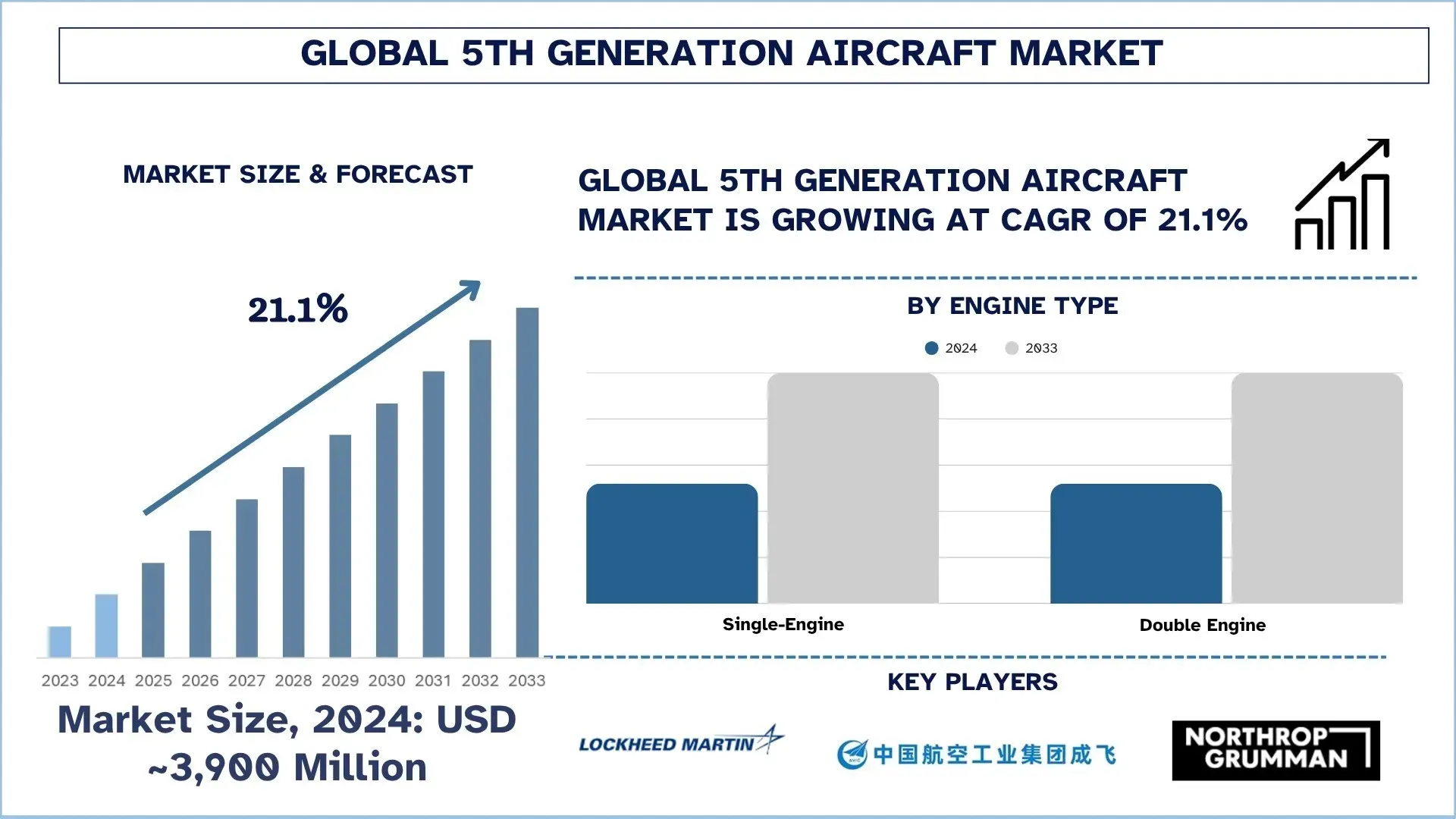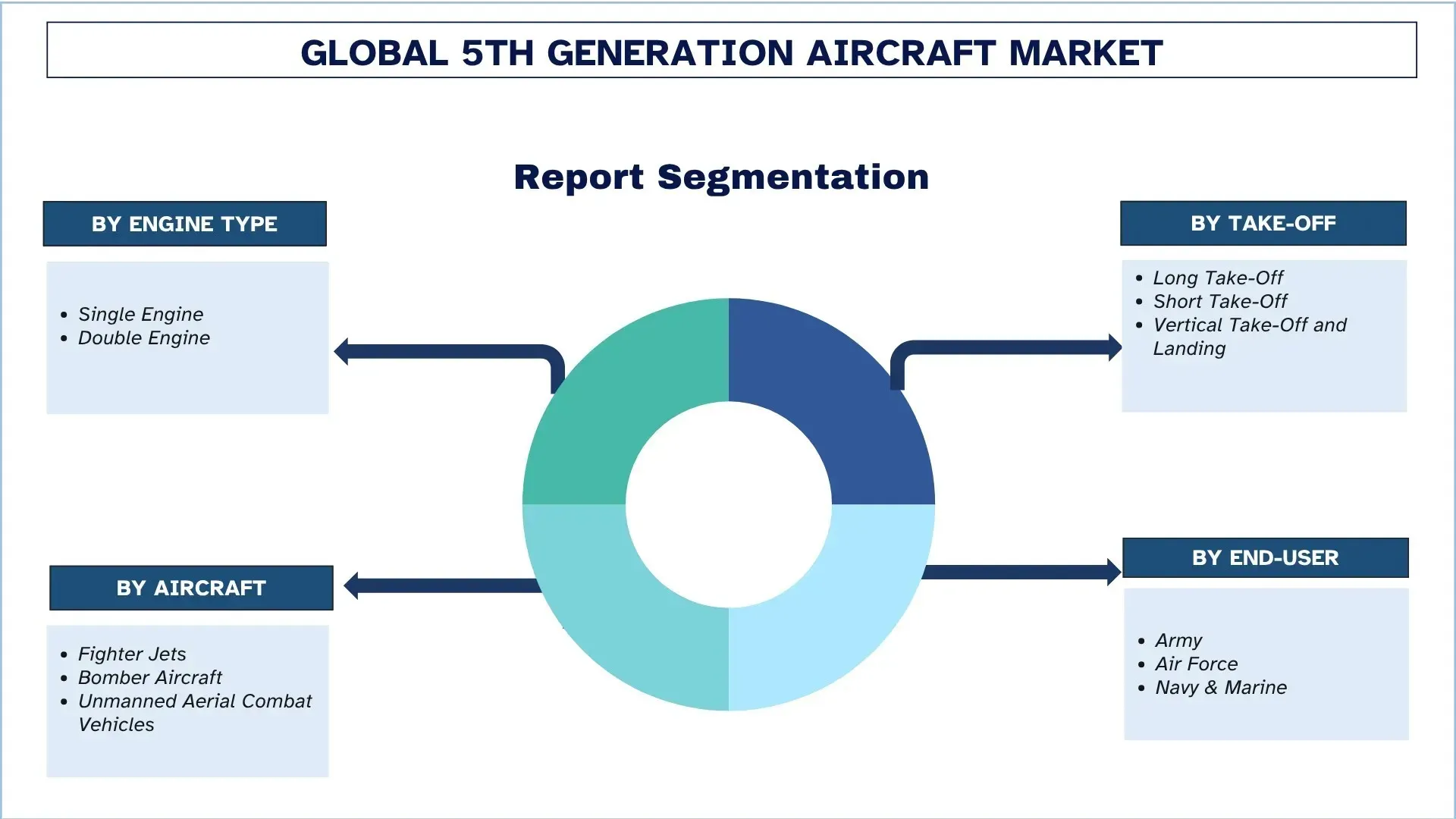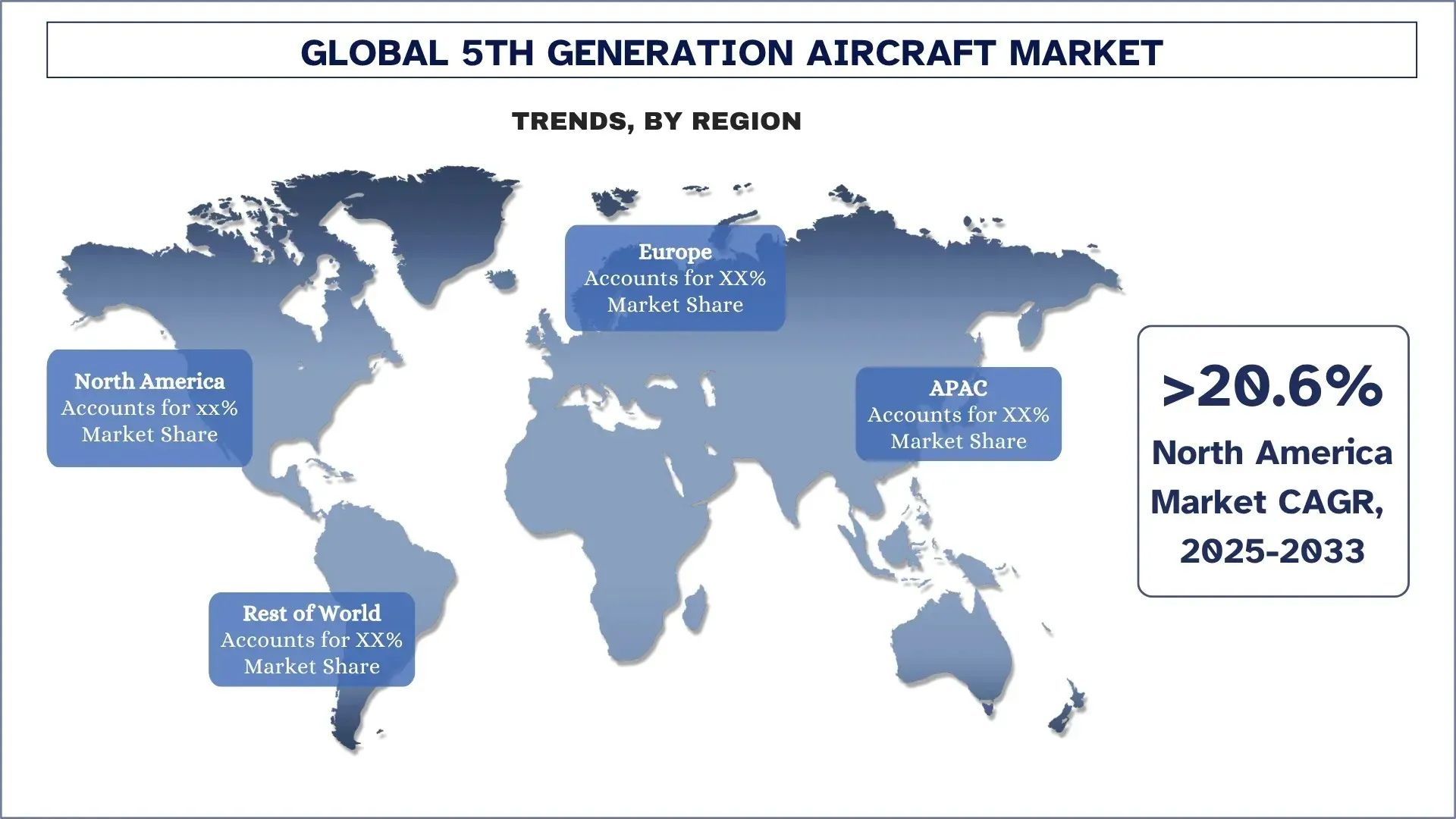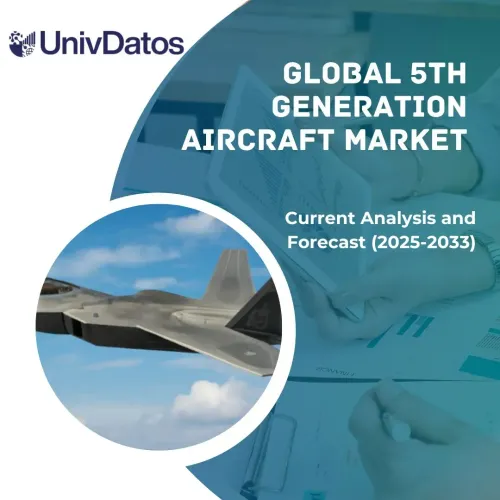- Home
- About Us
- Industry
- Services
- Reading
- Contact Us
5th Generation Aircraft Market: Current Analysis and Forecast (2025-2033)
Emphasis On Engine Type (Single-Engine and Double-Engine), By Take-Off (Long Take-Off, Short-Take-Off and Vertical Take-Off And Landing), By Aircraft Type (Fighter Jets, Bomber Aircrafts, and Unmanned Aerial Combat Vehicles) and , By End-User (Army, Air Force, and Navy & Marine), By Combat Capability (Supercruise and Non-Supercruise) Region/Country

Global 5th Generation Aircraft Market Size & Forecast
The Global 5th Generation Aircraft Market was valued at USD 3,900 million in 2024 and is expected to grow to a strong CAGR of around 21.1% during the forecast period (2025-2033F), owing to the rising demand for stealth jets.
5th Generation Aircraft Market Analysis
The 5th generation aircraft is a major leap from the existing 4th and 4.5 generation aircraft due to their lower observability in both thermal and radar-based signatures. These aircraft have higher survivability and carry weapons in an internal bay, which further reduces the chances of reflecting the radar waves through sharp missile hard points. Considering these factors, a large number of countries are either purchasing these aircraft or actively looking into the possibility of integrating these platforms into their military. As dog fights have been avoided due to the rise of advanced long-range stand-off weapons, as well as support from ground missile systems and availability of AWACS, a major doctrinal shift has been towards having a very low observability and locking the enemy before they can track and identify.
Global 5th Generation Aircraft Market Trends
This section discusses the key market trends that are influencing the various segments of the global 5th Generation Aircraft market, as found by our team of research experts.
Integration of AI and Wingman Systems:
Unmanned aircraft are one of the emerging categories across the globe. Many countries are looking forward to developing and integrating stealth UCAVs. These systems are unmanned as well as smaller in size as compared to conventional aircraft. Additionally, with the stealth design and radar-absorbent materials, survivability becomes multifold, which is crucial in targeting from stand-off distances.
These UCAVs are also developed to work as a loyal wingman to expand the strike capability of the fighter jets, as well as being effectively used for reconnaissance and ground strike applications. With the advancements in UAV technology, as well as the military becoming more conscious of using drones for enemy territory strikes to reduce pilot losses, the stealth wingman systems and UCAV segments will significantly rise across the globe. For instance, in 2024, Airbus exhibited its wingman-based stealth design for unmanned drones for augmenting the capabilities of manned aircraft through escorting as well as showcasing capabilities such as lower observability and advanced armaments.
5th Generation Aircraft Industry Segmentation:
This section provides an analysis of the key trends in each segment of the global 5th Generation Aircraft market report, along with forecasts at the global, regional, and country levels for 2025-2033.
Single-Engine Category has shown promising growth in the 5th Generation Aircraft Market.
Based on engine type, the global 5th generation aircraft market is bifurcated into single-engine and double-engine. Of these, the single-engine section has held the major market share. Some of the key factors attributed to the rise of the segment are the lower price of single-engine aircraft than their counterparts. Additionally, the majority of the export versions of the 5th generation aircraft are of a single type, such as F-35, J31, etc. These aircraft are of export versions with a lesser range and are more suited to the militaries that have limited budgets and want a lower operational cost aircraft. However, double-engine aircraft would also be in a notable position due to the domestic demand for double-engine aircraft such as F22, J20, and Su-57 aircraft.
Long Take-Off Category Dominates the 5th Generation Aircraft Market.
Based on Take-Off, the market is segmented into long take-off, short take-off, and vertical take-off and landing. Of these, long take-off has held major market share due to the extensive number of 5th generation jets used by the air forces as well as their lesser complexity in construction. These aircraft include J35 A, SU 57, F22, J20, J31, etc.
Fighter Jets Category Dominates the 5th Generation Aircraft Market.
Based on aircraft type, the market is segmented into fighter jets, bomber aircraft, and unmanned aerial combat vehicles. Presently, the fighter jets section has the major share in the overall demand for the 5th generation aircraft. As a large number of aircraft are demanded for air supremacy, suppression of enemy air defenses, stand-off engagement of aircraft, etc., the respective category is further anticipated to hold a major market share in the coming years.

North America is expected to grow at a considerable rate during the forecast period.
The North American 5th Generation aircraft market has held a dominant market share. As the region is home to the largest military bases in the world, with massive defense and capital acquisition budgets, the demand for the 5th generation aircraft is on the higher side. Additionally, countries as the US and Canada have extensively adopted 5th generation aircraft to expand their air supremacy in contested spaces. The region is also home to the largest 5th generation aircraft manufacturing companies, such as Lockheed Martin, Northrop Grumman, Boeing, etc. Considering these factors, the region is further anticipated to hold its dominant position in the acquisition of 5th generation aircraft, both in bomber and fighter jet categories in the forecasted years, i.e., 2025-2033.
The US is expected to grow at a considerable rate during the forecast period.
The US has held a major market share in the North American 5th-generation aircraft market. As the US has the highest budget in defense expenditure, surpassing the next 8 highest defense spenders combinedly, the country has been the key destination for the sales of 5th generation aircraft. Additionally, the adoption of 5th generation aircraft is the highest among all the countries, as currently there are 180 F22 and more than 1,000 F35 are in service with the US Air Force and the US Navy.
Furthermore, the country also has sole aircraft bombers B-2s in service and an under-development B-21 model to be integrated in the coming years. Considering these factors, the US is further anticipated to hold a notable share in the 5th generation aircraft market.

5th Generation Aircraft Industry Competitive Landscape:
The global 5th Generation Aircraft market is competitive, with several global and international market players. The key players are adopting different growth strategies to enhance their market presence, such as partnerships, agreements, collaborations, new product launches, geographical expansions, and mergers and acquisitions.
Top 5th Generation Aircraft Companies
Some of the major players in the market are Northrop Grumman Corporation, Lockheed Martin Corporation, Chengdu Aircraft Industry (Group) Co., Ltd., Boeing, United Aircraft Corporation, Turkish Aerospace Industries (TUSAŞ), Hindustan Aeronautics Limited, Mitsubishi Heavy Industries, and Korea Aerospace Industries, Ltd.
Recent Developments in the 5th Generation Aircraft Market
In 2024, the Pentagon and Lockheed Martin announced they are in the advanced phase of the agreement for the purchase of two more F-35 fighter jets.
India, being one of the major defense importers, is in an advanced phase of acquiring Su-57 jets from Russia, for which the Russian authorities are willing to provide technology transfer for domestic production.
In December 2024, Pakistan signed a deal with China for the acquisition of 40 J-31 fifth-generation fighter jets equipped with PL-17 long-range stand-off missiles.
Global 5th Generation Aircraft Market Report Coverage
Details | |
Base year | 2024 |
Forecast period | 2025-2033 |
Growth momentum | Accelerate at a CAGR of 21.1% |
Market size 2024 | USD 3,900 Million |
Regional analysis | North America, Europe, APAC, Rest of the World |
Major contributing region | North America is expected to dominate the market during the forecast period. |
Key countries covered | U.S., Canada, Germany, U.K., Spain, Italy, France, China, Japan, South Korea, and India |
Companies profiled | Northrop Grumman Corporation, Lockheed Martin Corporation, Chengdu Aircraft Industry (Group) Co., Ltd., Boeing, United Aircraft Corporation, Turkish Aerospace Industries (TUSAŞ), Hindustan Aeronautics Limited, Mitsubishi Heavy Industries, and Korea Aerospace Industries, Ltd. |
Report Scope | Market Trends, Drivers, and Restraints; Revenue Estimation and Forecast; Segmentation Analysis; Demand and Supply Side Analysis; Competitive Landscape; Company Profiling |
Segments Covered | by Engine Type, by Take-Off, by Aircraft Type, by End-User, by Combat Capability, by Region/Country |
Reasons to Buy the 5th Generation Aircraft Market Report:
The study includes market sizing and forecasting analysis confirmed by authenticated key industry experts.
The report briefly reviews overall industry performance at a glance.
The report covers an in-depth analysis of prominent industry peers, primarily focusing on key business financials, type portfolios, expansion strategies, and recent developments.
Detailed examination of drivers, restraints, key trends, and opportunities prevailing in the industry.
The study comprehensively covers the market across different segments.
Deep dive regional-level analysis of the industry.
Customization Options:
The global 5th Generation Aircraft Market can further be customized as per the requirements or any other market segment. Besides this, UnivDatos understands that you may have your own business needs; hence, feel free to contact us to get a report that completely suits your requirements.
Table of Content
Research Methodology for the Global 5th Generation Aircraft Market Analysis (2023-2033)
We analyzed the historical market, estimated the current market, and forecasted the future market of the global 5th Generation Aircraft market to assess its application in major regions worldwide. We conducted exhaustive secondary research to gather historical market data and estimate the current market size. To validate these insights, we carefully reviewed numerous findings and assumptions. Additionally, we conducted in-depth primary interviews with industry experts across the 5th Generation Aircraft value chain. After validating market figures through these interviews, we used both top-down and bottom-up approaches to forecast the overall market size. We then employed market breakdown and data triangulation methods to estimate and analyze the market size of industry segments and sub-segments.
Market Engineering
We employed the data triangulation technique to finalize the overall market estimation and derive precise statistical numbers for each segment and sub-segment of the global 5th Generation Aircraft market. We split the data into several segments and sub-segments by analyzing various parameters and trends, by Engine Type, by Take-Off, by Aircraft Type, by End-User, by Combat Capability, and by regions within the global 5th Generation Aircraft market.
The Main Objective of the Global 5th Generation Aircraft Market Study
The study identifies current and future trends in the global 5th Generation Aircraft market, providing strategic insights for investors. It highlights regional market attractiveness, enabling industry participants to tap into untapped markets and gain a first-mover advantage. Other quantitative goals of the studies include:
Market Size Analysis: Assess the current forecast and market size of the global 5th Generation Aircraft market and its segments in terms of value (USD).
5th Generation Aircraft Market Segmentation: Segments in the study include areas by Engine Type, by Take-Off, by Aircraft Type, by End-User, by Combat Capability, and by
Regulatory Framework & Value Chain Analysis: Examine the regulatory framework, value chain, customer behavior, and competitive landscape of the 5th Generation Aircraft industry.
Regional Analysis: Conduct a detailed regional analysis for key areas such as Asia Pacific, Europe, North America, and the Rest of the World.
Company Profiles & Growth Strategies: Company profiles of the 5th Generation Aircraft market and the growth strategies adopted by the market players to sustain the fast-growing market.
Frequently Asked Questions FAQs
Q1: What is the global 5th Generation Aircraft market’s current Market size and growth potential?
The global 5th Generation Aircraft Market was valued at USD 3,900 Million in 2024 and is expected to grow at a CAGR of 21.1% during the forecast period (2025-2033).
Q2: Which segment has the largest share of the global 5th Generation Aircraft market by Engine Type?
The Single Engine segment has held the major market share due to Lower operational cost as well as ample number of options available within the export categories.
Q3: What are the driving factors for the growth of the global 5th Generation Aircraft market?
• Rising Defense Expenditure on Stealth Aircraft: Global military expenditures have grown consistently over the years, with the bulk of funds being channeled into the evolving programs of the new generation of stealth aircraft. Nations are in dire need of procuring and developing their fifth-generation fighters due to their higher stealth, agility, and multirole capability in comparison.
• Increased Focus on Security and Geopolitical Tensions: Rising geopolitical instability and regional security threats are causing governments to realign their military strategies, with air power expansion at its core. The increase in the demand for fighter jets with technologically advanced features is especially marked in disputed areas such as the Indo-Pacific, Eastern Europe, and the Middle East.
Q4: What are the emerging technologies and trends in the global 5th Generation Aircraft market?
• Integration of AI and Wingman Systems: Many countries are looking forward to developing and integrating stealth UCAVs. These systems are unmanned as well as smaller in size as compared to conventional aircraft.
• Demand for Aircraft Carrier-based Stealth Jets: These aircraft are equipped with vertical take-off and landing technologies, which make them a suitable option for easy operations in aircraft carriers. Considering countries such as China and India with the rising budget and looking forward to adding more aircraft carriers, the demand for the 5th generation aircraft is anticipated to rise significantly in the coming years.
Q5: What are the key challenges in the global 5th Generation Aircraft market?
• High Development and Maintenance Costs: Fifth-generation aircraft involve complex engineering, stealth materials, and advanced electronics, leading to extremely high development and maintenance costs that strain defense budgets and extend production timelines.
• High Purchase and Operational Cost: The acquisition and operational lifecycle of fifth-generation fighters demands substantial financial investment, making them less accessible for smaller nations and increasing reliance on selective procurement or international partnerships.
Q6: Which region dominates the global 5th Generation Aircraft market?
The North America region dominates the global 5th Generation Aircraft market due to the rising demand for stealth jets.
Q7: Who are the key players in the global 5th Generation Aircraft market?
Some of the top 5th Generation Aircraft companies include:
• Northrop Grumman Corporation
• Lockheed Martin Corporation
• Chengdu Aircraft Industry (Group) Co., Ltd.
• Boeing
• United Aircraft Corporation
• Turkish Aerospace Industries (TUSAŞ)
• Hindustan Aeronautics Limited
• Mitsubishi Heavy Industries
• Korea Aerospace Industries, Ltd
Q8: What are the opportunities for companies within the Global 5th Generation Aircraft market?
Growing international collaboration offers a key opportunity in the fifth-generation aircraft market, as countries lacking full-scale development capabilities partner with more advanced nations to co-develop or acquire next-gen fighters. Such joint ventures facilitate technology transfer, cost-sharing, and faster deployment. Simultaneously, the emergence of developing countries expanding their defense budgets and modernizing air forces fuels demand for fifth-generation jets. Nations like India, Turkey, and South Korea are entering the space with indigenous or collaborative programs. This dual trend of cooperation and new market participation broadens the global footprint and accelerates innovation and adoption across diverse defense ecosystems.
Related Reports
Customers who bought this item also bought










